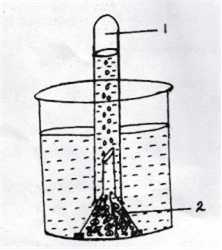 Long Answer Type
Long Answer TypeDifferentiate between the following pairs on the basis of what is mentioned within brackets:
(i) Human skin cell and Human ovum (number of chromosomes)
(ii) Sperm duct and fallopian tube (function)
(iii) Red Cross and WHO (one activity)
(iv) Rod cells and cone cells (pigment)
(v) LUBB and DUP (names of the valves whose closure produce the sound)
i.
| Human skin cell | Human ovum |
| Number of chromosomes is 46 | Number of chromosomes is 23 |
| Sperm duct | Fallopian tubes |
| Carries sperms from testis to urethra. | Carries egg from ovary to uterus. |
| Red Cross | WHO |
| Arrange ambulance service in all emergency situations. | Promote projects for research on diseases. |
iv
| Rod cells | Cone cells |
| Pigment present - Rhodopsin | Pigment present -Iodopsin |
v.
| LUBB | DUP |
| Tricuspid and Bicuspid valves get closed | Semilunar valves gets closed |
Given below is the outline of the human body showing the important glands:
(i) Name the glands marked 1 to 4.
(ii) Name the hormone secreted by part 2. Give one important function of this hormone.
(iii) Name the endocrine part of the part numbered 3.
(iv) Why is the part labelled 1 called the master gland? Which part of the forebrain controls the gland labelled 1?
(v) Name the gland that secretes the 'emergency hormone'.
The diagram of an apparatus given below demonstrates a particular process in plants. Study the same and answer the questions that follow:

(i) Name the apparatus.
(ii) Which phenomenon is demonstrated by this apparatus?
(iii)Explain the phenomenon mentiend in (ii) above.
(iv) State two limitations of using this apparatus.
(v) What is the importance of the air bubble in the experiment?
(vi) Name the structures in a plant through which the above process takes place.
(i) Draw a well-labelled diagram of the membranous labyrinth found in the inner ear.
(ii) Based on the diagram drawn above in (i) give a suitable term for each of the following descriptions:
l. The sensory cells that helps in hearing.
2. The part that is responsible for static balance of the body.
3. The membrane covered opening that connects the middle ear to the inner ear.
4. The fluid present in the middle chamber of cochlea.
5. The structure that maintains dynamic equilibrium of the body.
Give the Biological/technical term for the following:
(i) Complete stoppage of menstrual cycle in females.
(ii) Pigment providing colour to urine.
(iii) The vein which drains the blood from the intestine to the liver.
(iv) The canal through which the testes descend into the scrotum just before the birth of a male baby.
(v) The process causing an undesirable change in the environment.
(vi) The removal of nitrogenous wastes from the body.
(vii) The repeating components of each DNA strand lengthwise.
(viii) An alteration in the genetic material that can be inherited.
(ix) The process of uptake of mineral ions against the concentration gradient using energy from the cell.
(x) Blood vessels carrying blood to the left atrium.
The given diagram shows a stage during mitotic division in an animal cell:
i. Identify the stage. Give a reason to support your answer.
ii. Draw a neat labelled diagram of the cell as it would appear in the stage. Name the stage.
iii. In what two ways is mitotic division in an animal cell different from the mitotic division in a plant cell?
iv. Name the type of cell division that occurs during:
A. Growth nf a shoot
B. Formation of pollen grains.
The diagram given below is that of a developing human foetus. Study the diagram and then answer the questions that follow:
(i) Label the parts numbered 1 to 3 in the diagram.
(ii) Mention any two functions of the part labelled 2 in the diagram.
(iii) Explain the significance of the part numbered 3 in the diagram.
(iv) Define the term 'Gestation'. What is the normal gestational period of the developing human embryo?
(v) Mention the sex chromosomes in a male and female embryo.
The following diagram demonstrates a physiological process taking place in green plants.The whole setup was placed in bright sunlight for several hours. Study the diagram and answer the questions that follow:
i. What aspect of the physiological process is being examined?
ii. Explain the physiological process mentioned in (i)
iii. Label the parts numbered 1 and 2 in the diagram.
iv. Write a well-balanced chemical equation for the physiological process explained in (ii) above.
v. What would happen to the rate of bubbling or of the gas if a pinch of sodium bicarbonate is added to the water in the beaker? Explain your answer.
A homozygous tall plant (T) bearing red coloured (R) flowers is crossed with a
homozygous dwarf (t) plant bearing white (r) flowers:-
(i) Give the genotype and phenotype of the plants of F1 generation.
(ii) Mention the possible combinations of the gametes that can be obtained from the F1 hybrid plant.
(iii) State the Mendel's law of Independent Assortment'
(iv) Mention the phenotypes of the offsprings obtained in F2 generation.
(v) What is the phenotypic ratio obtained in F2 generation ?
Briefly explain the following terms:
(i) Reflex action
(ii) Power of accommodation
(iii) Photophosphorylation
(iv) Hormone
(v) Synapse
